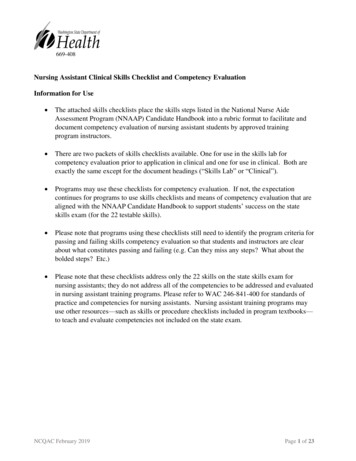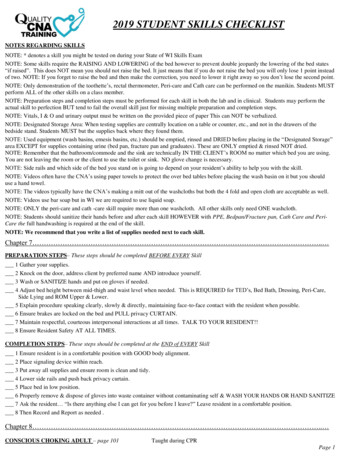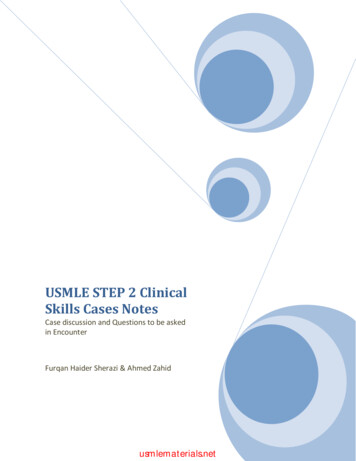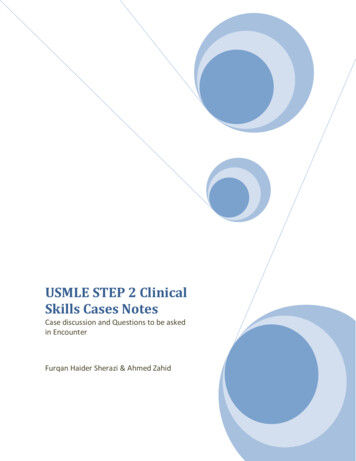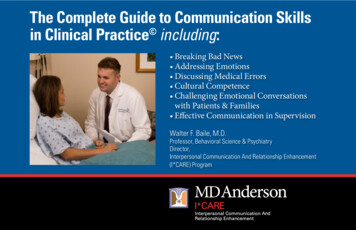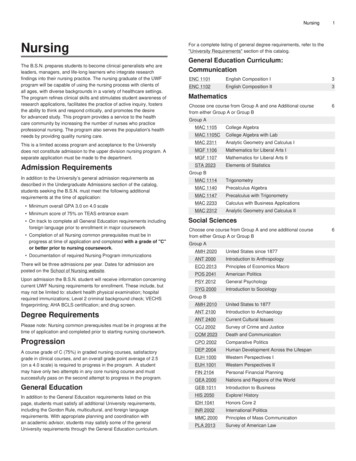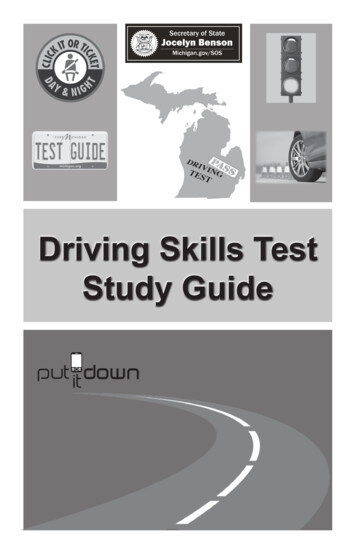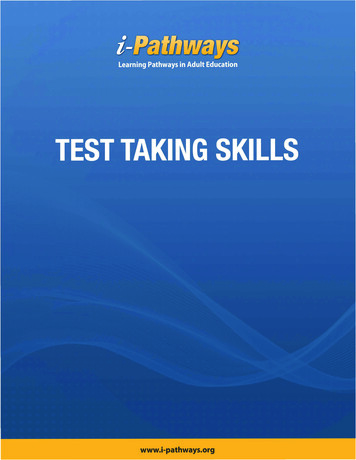
Transcription
Clinical Skills Test ChecklistThe procedures for skills are learned from yourinstructor, nurse aide textbooks, and other trainingmaterials. The procedure for any skill may include moredetail about important requirements than are shown inthe checkpoints. Your performance may include moredetail than is included in the checkpoints.During training, you learn many skills that are importantin caring for residents. There are 22 skills that are partof the Clinical Skills Test. When you are registered totest, a computer will decide which skills will be onyour test.A Clinical Skills Test consists of five scored skills. Allcandidates taking this test are scored on theHandwashing and Indirect Care skills. When you takeyour test, you will be given instructions for the otherthree skills that are part of your test. Because you maylearn to perform skills in different ways for differentresidents’ needs, you are given instructions thatdescribe how the skill is being tested. For example, ifyou test on the feeding skill, you will feed a residentpositioned in a chair. Remember, you are stillresponsible for knowing how to feed residents who arepositioned in other ways. The Knowledge (Written) Testmay also ask questions about feeding residents in otherpositions.A description of the instructions given to candidates foreach skill is provided below along with the checkpointsfor each skill. This description includes if a person ormannequin is used for the resident. Usually anothercandidate will play the role of the resident when aperson is used. In special situations, the evaluator mayneed to play the resident.While you are waiting to take the test, you will be givenGeneral Instructions to read. These are the basic rulesfor the Clinical Skills Test. For example, theseinstructions explain what you need to do when youwant to make a correction to a skill you are performing.These General Instructions are also available on thewebsite for your state atwww.prometric.com/nurseaide. You are encouragedto review them before you arrive at the test site.Each skill in the test has checkpoints. The evaluator(nurse) giving your test will use these checkpoints torate your performance. After you complete your test,the evaluator will enter his/her observations into acomputer. Prometric’s system will then determine yourresults. Your results will be provided to you on the dayof testing, unless a technology issue, such as a printerproblem at the test site, prevents the evaluator fromproviding your results. If you are not provided a scorereport on the day of testing, see the candidate bulletinfor information on accessing your results online.When you are called into the testing room to take yourtest, you will be shown around the testing room so youcan see where equipment and supplies are located. Thetesting room will be set up similar to a resident’s room.For example, personal care supplies such as theresident’s toothbrush, toothpaste, basins, and bedpanwill be in the resident’s bedside cabinet.When you are taking your Clinical Skills test, rememberthat you are required to actually perform the skills. Theevaluator is not allowed to answer any questions abouthow skills are performed.The checkpoints for each of the skills are listed on thepages that follow. It is important that you understandthat the checklists are not written as procedures. Thesecheckpoints are not provided to help you learn skills,but to help you understand what the evaluator will lookfor when you perform a skill.HandwashingHandwashingWhen taking the test, candidates are not giveninstructions about when to wash their hands. This isbecause nurse aides are expected to know that theirhands should be washed before any physical contact witha resident. Candidates are evaluated on how well theywash their hands (technique) during the first skill. InFlorida, where two nurses will be observing yourperformance throughout the test, one nurse will observeyour handwashing at the beginning of the first skill, andthe other nurse will observe your handwashing at the endof first skill.Does the candidate:After the first skill is completed, for the remainder of thetest, handwashing is evaluated as a part of Indirect Carewith the checkpoint, “Use Standard Precautions andInfection Control Measures when providing care.”Handwashing is one of the five skills scored in everyClinical Skills Test.Copyright 2018 Prometric Inc., aDelaware corporation. All rights reserved.11Begin handwashing by wetting hands and applyingsoap to hands?2Use friction to distribute soap and create lathercleansing front and back of hands, between fingers,around cuticles, under nails, and wrists?3Provide cleansing friction for a minimum of20 seconds with hands lathered with soap?4Rinse hands and wrists removing soap?5Use clean paper towel(s) to dry hands and wrists,and dispose of used paper towel in trash?6End handwashing skill with clean hands avoidingrecontamination of hands before procedurecompleted (e.g., having direct contact with faucethandles or sink surfaces once hands washed)?20180119
CLINICALSKILLSTESTCHECKLISTAmbulate the resident using a transfer/gait beltIndirect CareIndirect Care is a skill that is evaluated while you performeach skill. This skill evaluates behaviors that are commonto any resident care such as: infection control, safety,communication, and resident preferences, needs, comfortand rights. You are not given instructions to perform theIndirect Care skill. The evaluator watches for thesebehaviors while you perform each skill. In thecheckpoints provided for each skill below, Indirect Carecheckpoints are identified with an “(IC)” at the end.Indirect Care is one of the five skills scored in everyClinical Skills Test. The Indirect Care checkpoints are:13Remove transfer/gait belt from resident’s waistwithout harming resident (e.g., pulling transfer/gaitbelt) when seated in chair after ambulation?14Maintain own body mechanics when assistingresident to stand and sit?15Leave resident positioned in chair in proper bodyalignment and hips against back of seat?16Ask resident about preferences during care? (IC)17Use Standard Precautions and infection controlmeasures when providing care? (IC)Does the candidate:18Ask resident about comfort or needs during care orbefore care completed? (IC)19Promote resident’s rights during care? (IC)20Promote resident’s safety during care? (IC)1Greet resident, address by name, and introduceself? (IC)2Provide explanations to resident about care beforebeginning and during care? (IC)3Ask resident about preferences during care? (IC)4Use Standard Precautions and infection controlmeasures when providing care? (IC)5Ask resident about comfort or needs during care orbefore care completed? (IC)6Promote resident’s rights during care? (IC)7Promote resident’s safety during care? (IC)Assist resident needing to use a bedpanThe candidate is asked to help a resident who has askedfor a bedpan. The role of the resident is played by aperson who will be wearing a hospital-style gown overclothing. For the purposes of testing, the candidate willpretend that the resident (actor) is not wearingunderpants.Does the candidate:Ambulate the resident using a transfer/gait beltThe candidate is asked to walk a resident who needssome assistance to stand. A transfer/gait belt is usedwhile walking the resident. The role of the resident isplayed by a person.1Greet resident, address by name and introduce self?(IC)2Provide explanations to resident about care beforebeginning and during care? (IC)3Place protective pad on bed over bottom sheet,under buttocks/upper thigh area, before placingbedpan, and remove the pad after bedpan isremoved?4Place and remove bedpan by either having residentpositioned on side to turn on/off back, onto/offbedpan, or having resident raise hips off bed?5Position bedpan under resident according toform/shape of the selected bedpan?6Position bedpan to allow for collection?7Raise the head of the bed after positioning theresident on the bedpan, and lower the head of thebed before removing bedpan?8Ask resident to call when finished or if needs help,leaving call light within the resident’s reach beforeleaving resident to use bedpan?9Leave toilet paper within resident's reach beforeleaving resident to use bedpan?10Wear gloves when removing bedpan and whileemptying and cleaning bedpan?11Empty contents of bedpan into toilet, rinse bedpanpouring contents into toilet, and dry bedpan?12Offer resident damp washcloth or paper towel, orhand wipe, to cleanse hands after bedpan used,before end of care?13Complete skill storing bedpan and toilet paper,placing soiled linens in hamper, and disposing oftrash?Does the candidate:1Greet resident, address by name and introduce self?(IC)2Provide explanations to resident about care beforebeginning and during care? (IC)3Apply transfer/gait belt before standing resident,placing around the resident’s waist and overclothing, secure so that only flat fingers/hand fitunder belt, and the belt does not catch skin or skinfolds (e.g. breast tissue)?4Provide signal or cue to resident before assisting tostand?5Assist resident to stand while holding onto thetransfer/gait belt without holding belt only at thefront or only at nearest side (if assisting to standfrom the side)?6Ask about how resident feels upon standing?7Walk resident while standing to the side and slightlybehind resident?8Provide support while walking resident with an armaround resident’s back holding transfer/gait belt?9Ask about how resident feels during ambulation?10Walk resident at least 10 steps?11Assist resident to turn and have back of legspositioned against the seat of chair before residentsits?12Provide support to sit resident back into chair?2
CLINICALAssist resident needing to use a bedpan14Ask resident about preferences during care? (IC)16Use Standard Precautions and infection controlmeasures when providing care? (IC)17Ask resident about comfort or needs during care orbefore care completed? (IC)18Promote resident’s rights during care? (IC)19Promote resident’s safety during care? (IC)TESTCHECKLISTChange bed linen while the resident remains in bedKeep resident positioned a safe distance from theedge of the bed at all times?15SKILLS18Promote resident’s rights during care? (IC)19Promote resident’s safety during care? (IC)Change resident’s position to asupported side-lying positionThe candidate is asked to change the position of aresident who is lying on his/her back, to a side-lyingposition. The resident requires support to remainpositioned on the side. The role of the resident is playedby a person.Does the candidate:Change bed linen while the resident remains in bedThe candidate is asked to change the top and bottomsheets and pillowcase on the bed while the resident staysin the bed. The role of the resident is played by a person.(not tested in Wyoming)Does the candidate:1Greet resident, address by name, and introduceself? (IC)2Provide explanations to resident about care beforebeginning and during care? (IC)3Assist resident with turning onto side before placingpositioning devices?1Greet resident, address by name and introduce self?(IC)4Keep resident positioned a safe distance from theedge of the bed at all times?2Provide explanations to resident about care beforebeginning and during care? (IC)53Keep resident positioned a safe distance from theedge of the bed at all times?Use positioning device/padding or pillow under oragainst resident’s back that maintains side-lyingposition?64Remove and replace bottom sheet on one side ofthe bed, before turning resident to remove andreplace sheet on the other side of the bed?Leave resident positioned on side with upper kneebent in front of the lower leg?7Support resident’s top leg by placing device(s)/padding or pillow(s) between legs?5Keep resident positioned on a bottom sheetthroughout procedure?86Secure bottom sheet to mattress (e.g., for fittedsheet secure over all four corners of the mattress;for flat sheet, tuck at head of bed and on sides andextend toward bottom of mattress so that resident’sheels are not against any exposed mattress)?Position device(s)/padding or pillow(s) placedbetween legs so that bony prominences of theknees and ankles are separated?9Leave the resident positioned on side without lyingon the shoulder, arm, and hand?10Leave pillow placed under head positioned to alsosupport the resident’s neck and chin?11Place device/padding or pillow positioned to supportthe resident’s upper arm, supporting both theshoulder and arm?12Ask resident about preferences during care? (IC)13Use Standard Precautions and infection controlmeasures when providing care? (IC)14Ask resident about comfort or needs during care orbefore care completed? (IC)15Promote resident’s rights during care? (IC)16Promote resident’s safety during care? (IC)7Leave bottom sheet free of creases or folds?8Turn or position resident to remove or replacesheet(s) without pulling sheets in a manner thatcreates friction and risks skin shearing?9Replace the top sheet over resident with a cleansheet?10Tuck top sheet under foot of mattress leaving sheetplaced loosely, avoiding pressure against toes andallowing for foot movement?11Leave top sheet placed on top of resident to coverbody up to shoulder level, without tucking in alongsides?12Keep pillow positioned under resident’s headthroughout and at the end of the procedure, exceptwhen removed briefly to replace pillowcase?13Complete procedure with resident positionedbetween the top and bottom sheet?14Complete skill placing soiled linens in hamper anddisposing of trash?15Ask resident about preferences during care? (IC)16Use Standard Precautions and infection controlmeasures when providing care? (IC)17Ask resident about comfort or needs during care orbefore care completed? (IC)3
CLINICALSKILLSTESTCHECKLISTEmpty contents of resident’s urinary drainage bag,and measure and record urine output on an Intakeand Output (I&O) formDress a resident who has a weak armThe candidate is asked to put a lon
Clinical Skills Test Checklist During training, you learn many skills that are important in caring for residents. There are 22 skills that are part of the Clinical Skills Test. When you are registered to test, a computer will decide which skills will be on your test. A Clinical Skills Test consists of five scored skills. All candidates taking this test are scored on the Handwashing and .
